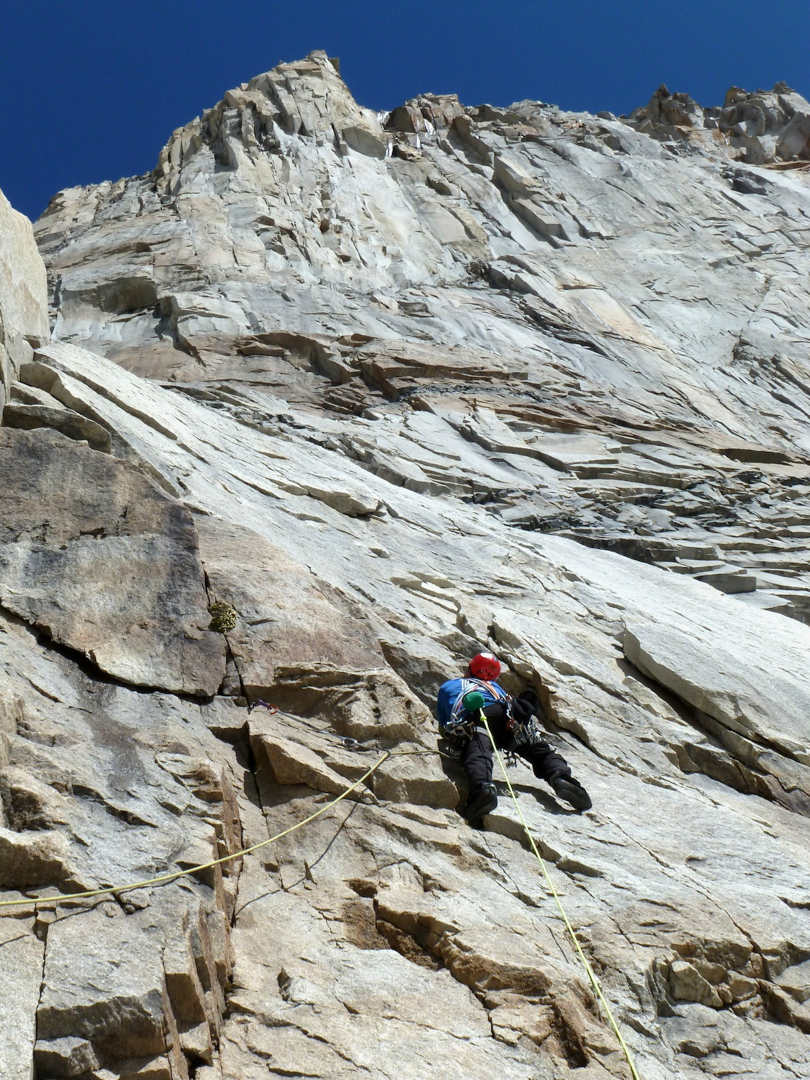North Tower, East Face, Plate Tectonics
South America, Chile, Torres del Paine

Amy Ness and I began climbing the east face of the North Tower on January 9, 2013. We planned for 12 days on the wall for an all-free, capsule-style ascent. During 15 days on the wall, we had 10 days of fantastic weather. However, with good weather comes rock fall, ice fall, avalanches, and things that want to be pushed out of memory: the chopping of ropes, meteor showers of rocks, and the slow destruction of our portaledge.
We began climbing at the toe of the buttress on a seahorse-shaped flake 30m above the glacier, just right of a giant left-facing corner capped by a dark roof. From here, the wandering began. We ascended dikes, slammer splitters, and crystal pods. The quality of rock transformed the entire way—from great, to terrible, to unreal, to bulletproof and sharp. En route we discovered travels from the past—an aborted Chilean route named Hasta Chonchi by Francisco Parada and Felipe Gonzales Donoso, who attempted the line twice. We know our route crossed theirs twice and joined it for a pitch and a half.
From pitch 13 onward, the climbing got wild, as we cut hard right out of an always-dripping alcove toward the headwall. We worked the Gateway Pitch (pitch 13) for a day and a half, placing three bolts and fixing three pitons. We set our high camp here for the rest of the journey and battled this 45m pitch of sustained 5.11 and 5.12 climbing. Once it was completed, we stretched our heads back and gazed at the headwall’s coarse, slammer, overhanging cracks.
Day 12 had us in the middle of the headwall (pitch 14). Supplies were low and rationing had begun far below. We talked about how much time the Gateway Pitch had cost us, but we knew we had to be close to the cumbre. Pitch 14 went at 5.11 C1—the two meters of horizontal C1 will go free on a rail below the roof. The summit at this point had become more important than freeing the pitch, so we decided to press on. Above, we fixed 70m up a fantastic 5.11 offwidth.

An early rise the following day had us jugging 160m of fixed line above our camp for the final summit push. Of our six remaining pitches to the summit, the first two were 65m rope-stretchers (sustained 5.10). The next four pitches climbed through a sea of blocks, meandering around to the south side of the prow on the final summit cube. By pitch 18 we had dumped all nonessential gear and begun simul-climbing. We toped out our route, Plate Tectonics (3,000’, 21 pitches, VI 5.12 C1-) on January 23 in a full whiteout. The camera flashed red, took one photo, and then died.
We spent two days descending the route, facing intense rock fall and little to eat. We later found out that a record heat wave had swept over Patagonia. We were fortunate to be part of this weather window in Valle Ascensio—we just happened to feel the tower shift and move the entire time.
[Editor’s note: Following the climb, Moser and Ness made an attempt on the east face of the Central Tower, hoping to establish its second free route. They climbed 13 pitches free (up to 5.11) before a massive storm forced them to bail. They tenatively called the unfinished route Going for a Wander.]













